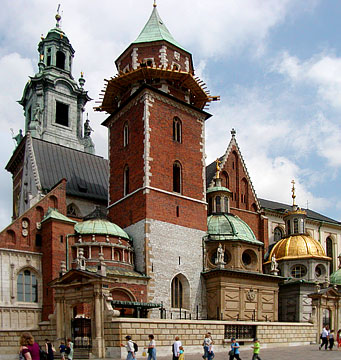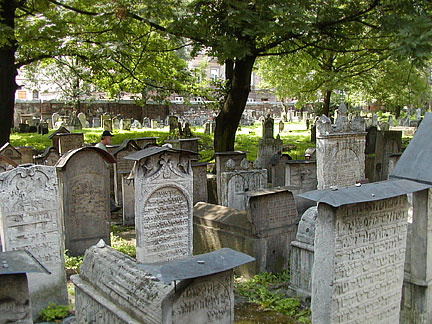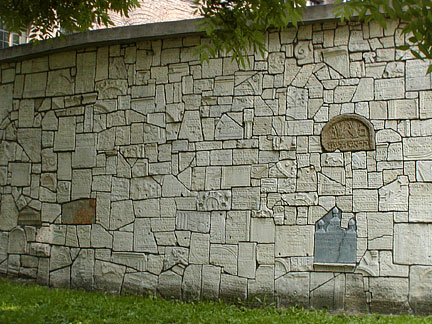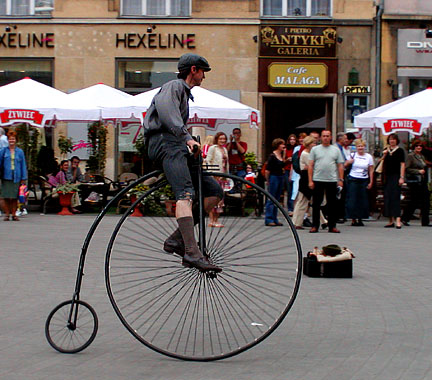|
|
Krakow is the third largest city in Poland and dates from the 7th century, making it one of the oldest cities in the country. Located on the Vistula, the longest river in Poland, it sat at the crossroads of the Western European to Byzantium and the the southern Europe to Baltic trading routes. It was a big trading center and was governed by a Prince Krak, which is how it got its name. The photo below is the castle and cathedral on Wawel Hill, overlooking the Vistula River.
|
|
|
The only large Polish city whose architecture survived W.W.II intact, Krakow has suffered severly from pollution and neglect from the communist years which has taken its toll on the buildings. When we visited in July 2003, we found a beautiful, lively city with many historic buildings in good condition. The city and its residents have spent a good deal of time and money refurbishing the long-neglected buildings.
As a result of this history, the old town center still has the original medieval street layout, although the homes have been rebuilt over the centuries. All construction from the 20th century occurred outside the central area, keeping it intact. The old city was completely surrounded by 3 miles of fortifications with 40 towers and 7 gates. Only 1 of the original gates still exists at the north end of town (above, left).
The center of the old town is a large open square is highlighted by the town hall tower from the 15th century (above, left). This is the largest medieval square in Europe. All around the square are the palaces from the rich merchants of the time. Some of these can be seen in the background of the photo. Today, the ground floors are shops and restaurants with outdoor seating areas.
Dominating the center of the square is the 16th century Renaissance Cloth Hall, as Krakow was known for its fabrics (above, left). Today, outdoor cafes line the outer perimeter while a crafts fair is held inside (above right). Upstairs houses the Gallery of 19th century Polish Paintings.
|
|
At the north end of the square stands the imposing St. Mary’s Cathedral (below). Inside is the Wit Stwosz Altar from 1489 that is a beautiful piece of medieval art and is the largest of its kind in Europe. It is made of oak and linden wood, then gilded. But as photos are not allowed inside, we have no pictures.
All the walls inside the cathedral are painted in intricate colorful designs, a type of decoration we have not seen before. Outside, it is obvious the towers are designed differently. The story has it that 2 brothers were the architects and one was more talented than the other. The talented one is on the left and when the other brother saw it, he became jealous and killed his brother. Then, feeling guilty for what he had done, he committed suicide by jumping from his unfinished tower.
The tower on the left is taller as it was used as a lookout tower. In 1241 when the Tartars invaded, the watchman played his trumpet to warn the citizens of the impending attack. However, he never finished his warning as a Tartar arrow pierced his neck. To this day, a trumpeter sounds the hour with this unfinished tune. The local firemen have a monitoring station in the tower and they perform the trumpet song. The tune is played four times, once in each direction. At noon, radio stations all over Poland transmit the tune.
|
|
|
A few blocks outside the square is the Krakow University built after the devastating fires of 1495. It was here in the Collegium Maius (the Great College) where Copernicus studied. The photo at right shows the inner courtyard of the Collegium Maius in the late Gothic style, used today for University events.
|
|
|
|
|
At the south end of the old town stands the 13th century Franciscan Church which was the first church built of bricks in Krakow. In the fire of 1851 the interior was destroyed although the building remained. In the renovation, windows were designed in the Art Nouveau style by Wyspianski (below, right). They are absolutely gorgeous and very rare.
|
|
Further south is the Kanonicza Street (above), home to many fine old buildings once used by the church. Today they have almost all been renovated, but there was one remaining, a reminder of the condition they all were in 10 years ago before all the restoration began (above, left). When we saw this one, we got a real impression of the amount of work that has been accomplished over the last 10 years. The difference is truly amazing! With each building renovated, there are always secrets found hidden within the walls in terms of architectural surprises. Often they find the buildings are much older than previously thought.
|
|
South of the old town area sits Wawel, a hill topped with the castle and cathedral, both of which are strong symbols of Poland. Wawel Cathedral (1364) was the coronation and burial place of Polish royalty for 4 centuries. At right is a view of the entrance to Wawel from the old town area. As both the Cathedral and Castle needed much renovation after years of neglect, private funding was sought to help finance the work. Plaques line the wall stating the donor of the funds, mostly from the early 1920s. We noticed many from Chicago, where the largest population of Poles outside Poland live.
The cathedral itself is made of several cathedrals which have been added on over the years. The result is a conglomeration of domes and peaks punctuating the skyline (below, right).
The gold domed Sigismund Chapel (1539) in the right of the photo below is considered to be the finest Renaissance construction in Poland. During the Nazi occupation, a plan was considered to remove the gold from the roof, but they soon found that as it was gilt, it would cost more to remove it than it was worth.
|
|
The bell tower houses Poland’s largest bell at 11 tons. It takes six men to ring the bell and it is used only on important state occasions such as their day of independence. Rumor has it that if you touch the bell with your left hand while making a wish, it will come true
|
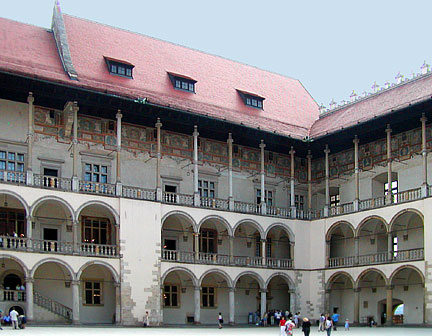 . .
|
|
|
Sitting next to the Cathedral is the Castle from the 16th century. The central area of the castle is a Renaissance Italian arcaded gallery (above, left) once painted in bright colors and friezes. Today, only a few friezes on the upper floors remain. Today many fine exhibits are housed in the buildings surrounding the courtyard.
The story of Krakow is not complete without a view of the Jewish life in the city. A small city near Krakow called Kazimierz was created in 1335 by King Kazimierz III to improve commerce as he understood the importance of competition between neighboring towns. In the 15th century the Jews were expelled from Krakow and they resettled in an area in Kazimierz, separated from the larger Christian quarter by a wall. The Jews had the freedom to enter Krakow as long as they agreed to 2 conditions:
- They would use the local language.
- They would dress in modern clothes.
|
|
The Jewish quarter grew over the centuries as Jews flocked there from all over Europe, fleeing persecution in their home countries. By the early 1900s there were over 65,000 Jews living in Kazimierz. During the war the Nazis relocated Jews to a walled ghetto south of the river. They were later exterminated in the nearby Plaszow death camp, as portrayed in the movie, Schlinder’s List. In all, about 5000 were saved, many of them on Schlinder’s list. Kazimierz was used as the location for filming much of the film as the Jewish Quarter was still intact. Today many of the storefront signs made for the film still adorn the buildings.
|
|
|
Many old synagogues still remain today, although the current practicing Jewish population numbers about 140. Beside the Remu’h Synagogue is the Remu’h Cemetery (above), used from the mid-16th century to the 18th century, survives today because most of it was buried before the war and the Nazi’s didn’t find it. When the Nazis did find a Jewish cemetery, it was common practice to break up the headstones and use the pieces for pavement. The wall of the cemetery (right) has become a monument as pieces of broken gravestones found in pavements have been dug out and used to create this mosaic. (Note: The metal plated added to the top of the gravestones in the photo above have been placed there to protect the gravestones from further damage by pollution and acid rain).
|
|
|
|
|
One of the things we enjoyed about Krakow was strolling around the city, especially the main square where often there were street performers to entertain the tourists and hopefully make a few Zloty. Our favorite was a jazz group that was quite good. One of the most unusual was the young man riding his penny farthing. He was quite practiced at this difficult maneuver and it is not often we see someone riding this old contraption.
|
|
|
Of course, while we were doing all this walking around town, we had to stop occasionally for a beer or cold refreshment. One one particularly warm day we enjoyed our fruit and ice cream sundaes on the main square, listening to several groups playing folk music.
Overall we really enjoyed Krakow and feel that it has a bit of something for everyone. The walking tour was very informative, the food was great (with a wide variety), there are numerous sites to see and the atmosphere was pleasant and relaxed.
|
|
|
|

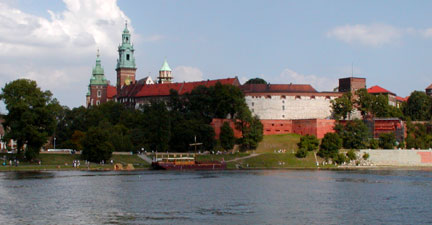

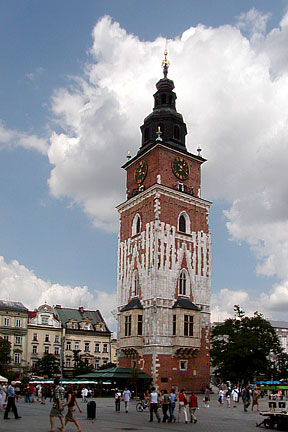
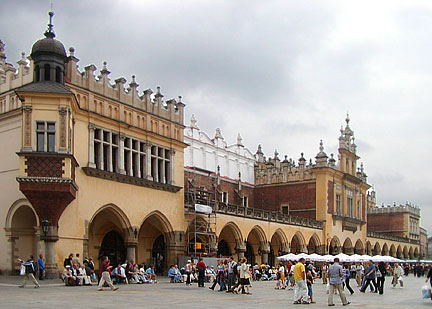
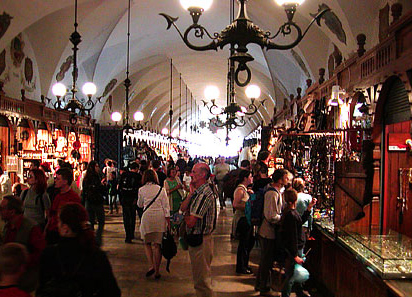

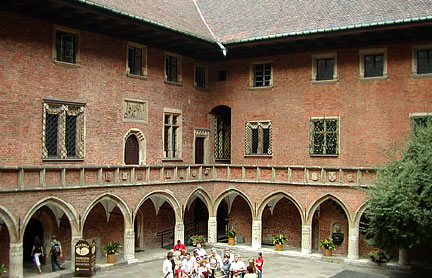

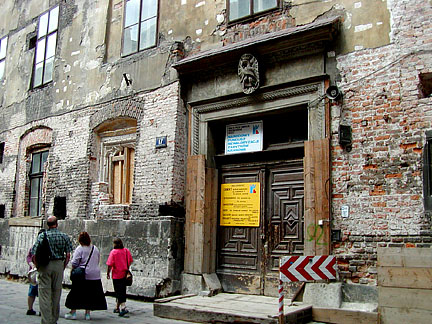
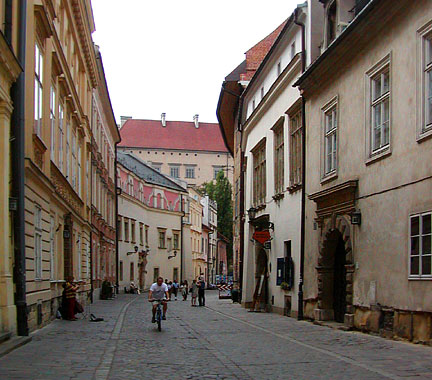

 .
.